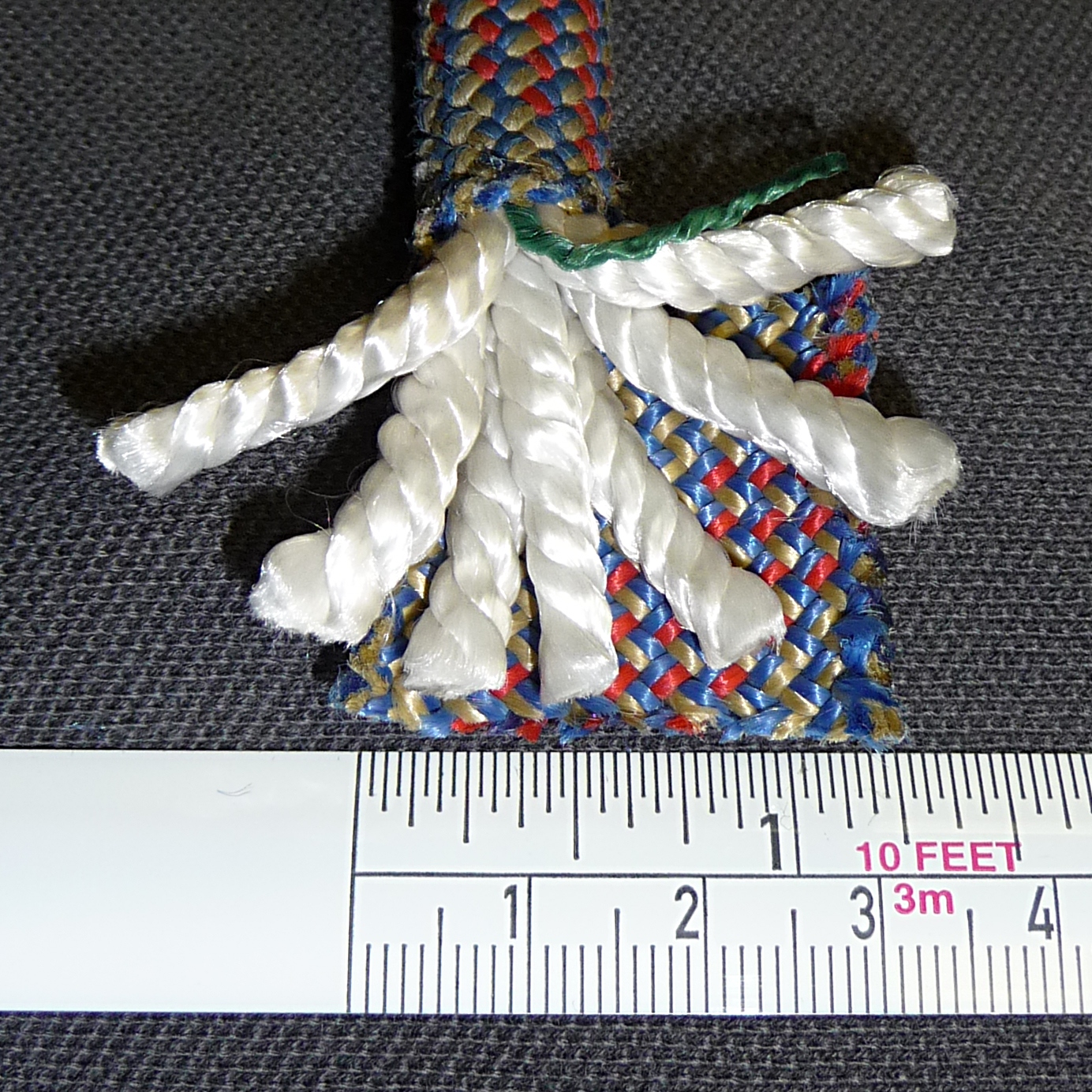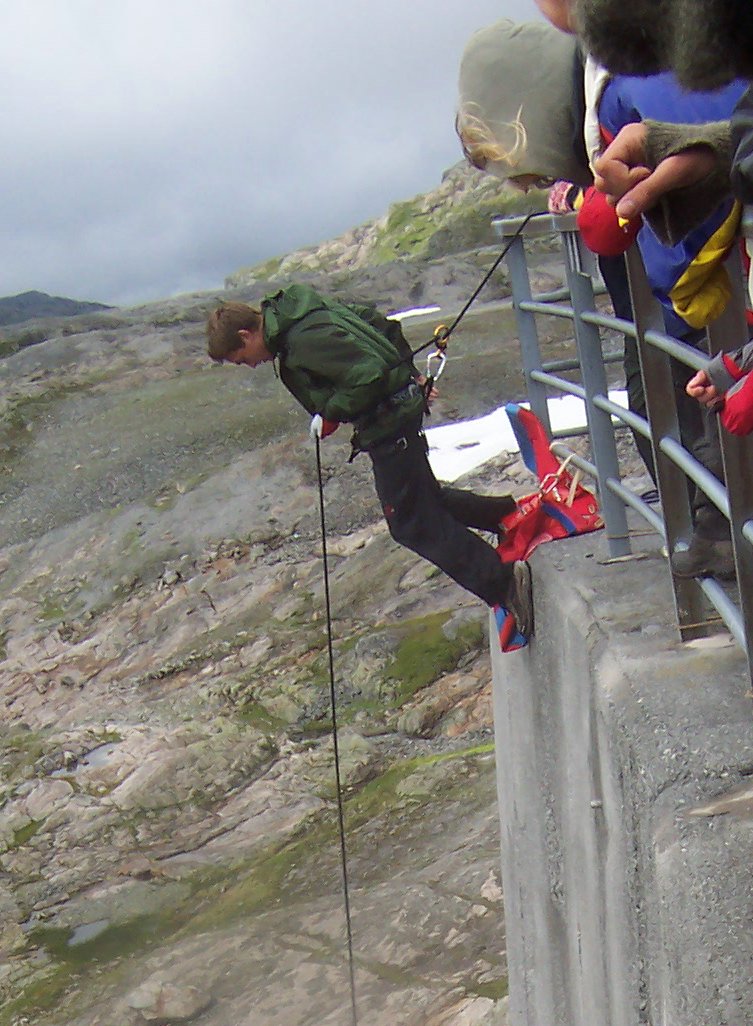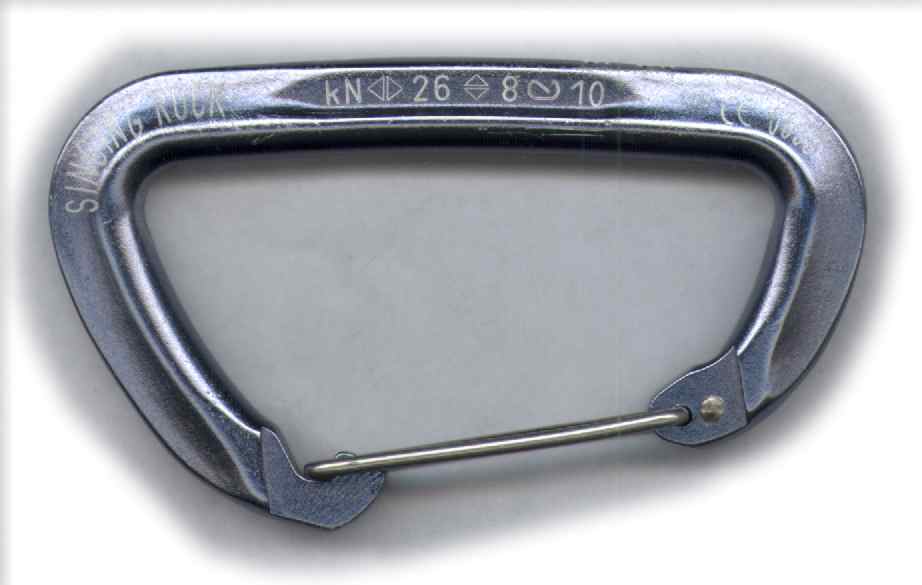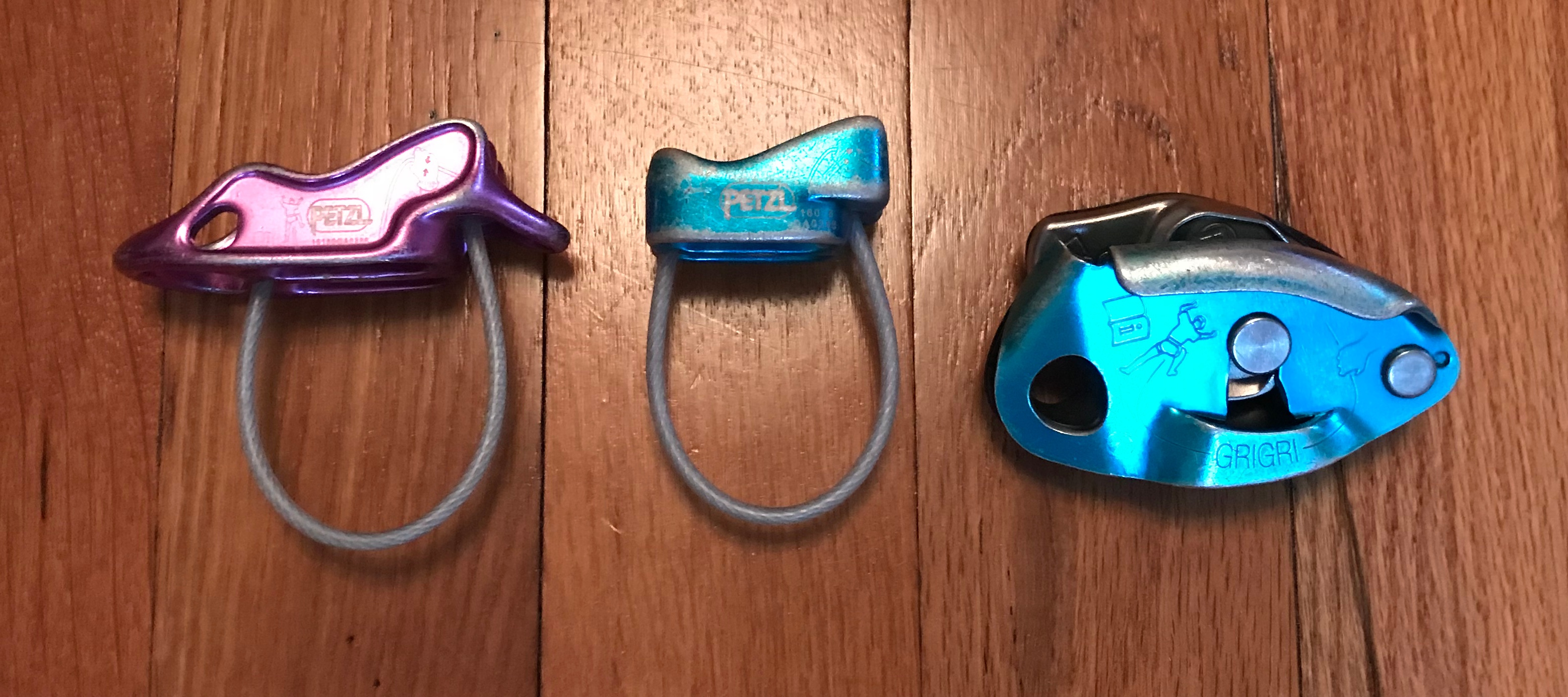|
Dynamic Rope
A dynamic rope is a specially constructed, somewhat elastic rope used primarily in rock climbing, ice climbing, and mountaineering. This elasticity, or stretch, is the property that makes the rope dynamic—in contrast to a static rope that has only slight elongation under load. Greater elasticity allows a dynamic rope to more slowly absorb the energy of a sudden load, such from arresting a climber's fall, by reducing the peak force on the rope and thus the probability of the rope's catastrophic failure. A kernmantle rope is the most common type of dynamic rope now used. Since 1945, nylon has, because of its superior durability and strength, replaced all natural materials in climbing rope. Rope types Dynamic climbing ropes are classified into three categories: Single ropes, twin ropes, and half ropes (also referred to as 'double ropes'). *Single ropes are designed to be used alone, and are by far the most common, and used for top-roping, sport climbing, and trad climbing. * ... [...More Info...] [...Related Items...] OR: [Wikipedia] [Google] [Baidu] |
Kernmantle Climbing Rope Dynamic Sterling 10
Kernmantle rope () is rope constructed with its interior core protected by a woven exterior sheath designed to optimize strength, durability, and flexibility. The core fibers provide the tensile strength of the rope, while the sheath protects the core from abrasion during use. This is the only construction of rope that is considered to be life safety rope by most fire and rescue services. Parachute cord Parachute cord (also paracord or 550 cord when referring to type-III paracord) is a lightweight nylon kernmantle rope originally used in the suspension lines of parachutes. This cord is useful for many other tasks and is now used as a general purpose utility cord by both military personnel and civilians. Use as climbing rope One of the uses of kernmantle rope is as climbing rope. Nylon ropes that were used in yachts for hauling were tested and found useful in climbing and caving and are now the modern standard. The German company Edelrid introduced the first kernmantel rope i ... [...More Info...] [...Related Items...] OR: [Wikipedia] [Google] [Baidu] |
Abseiling
Abseiling ( ; ), also known as rappelling ( ; ), is the controlled descent of a steep slope, such as a rock face, by moving down a rope. When abseiling, the person descending controls their own movement down a static or fixed rope, in contrast to Belaying, lowering off, in which the rope attached to the person descending is paid out by their belayer. Description The technique is used by Climbing, climbers, mountaineers, Caving, cavers, Canyoning, canyoners, search and rescue and rope access technicians to descend cliffs or slopes when they are too steep or dangerous to descend without protection. Many climbers use this technique to protect established Anchor (climbing), anchors from damage. Rope access technicians also use this as a method to access difficult-to-reach areas from above for various industrial applications like maintenance, construction, inspection and welding. To descend safely, abseilers use a variety of techniques to increase the friction on the rope to t ... [...More Info...] [...Related Items...] OR: [Wikipedia] [Google] [Baidu] |
Static Rope
A static rope is a low-elongation rope that is designed to stretch minimally when placed under load, typically less than 5%. In contrast, a dynamic rope is designed to stretch up to 40%. Static ropes have a wide variety of uses, for instance in fire rescue operations and caving. Static ropes have some applications in climbing, such as hauling gear, though lead climbing is always done with a dynamic rope, since a fall on a static rope is stopped too quickly and may lead to serious injury. Abseiling, however, is best done with a static rope or with a dynamic rope with low elasticity. Among other things, static ropes are often used for hauling up gear and other things. because of their low elongation and high weight limit, they excel at doing this job. See also *Kernmantle rope Kernmantle rope () is rope constructed with its interior core protected by a woven exterior sheath designed to optimize strength, durability, and flexibility. The core fibers provide the tensile strength ... [...More Info...] [...Related Items...] OR: [Wikipedia] [Google] [Baidu] |
Fall Factor
In lead climbing using a dynamic rope, the fall factor (''f'') is the ratio of the height (''h'') a climber falls before the climber's rope begins to stretch and the rope length (''L'') available to absorb the energy of the fall, :f = \frac. It is the main factor determining the violence of the forces acting on the climber and the gear. As a numerical example, consider a fall of 20 feet that occurs with 10 feet of rope out (i.e., the climber has placed no protection and falls from 10 feet above the belayer to 10 feet below—a factor 2 fall). This fall produces far more force on the climber and the gear than if a similar 20 foot fall had occurred 100 feet above the belayer. In the latter case (a fall factor of 0.2), the rope acts like a bigger, longer rubber band, and its stretch more effectively cushions the fall. Sizes of fall factors The smallest possible fall factor is zero. This occurs, for example, in top-rope a fall onto a rope with no slack. The rope stretches, so ... [...More Info...] [...Related Items...] OR: [Wikipedia] [Google] [Baidu] |
Climbing Rope
A dynamic rope is a specially constructed, somewhat elastic rope used primarily in rock climbing, ice climbing, and mountaineering Mountaineering, mountain climbing, or alpinism is a set of outdoor activities that involves ascending mountains. Mountaineering-related activities include traditional outdoor climbing, skiing, and traversing via ferratas that have become mounta .... This elasticity, or stretch, is the property that makes the rope dynamic—in contrast to a static rope that has only slight elongation under load. Greater elasticity allows a dynamic rope to more slowly absorb the energy of a sudden load, such from arresting a climber's fall, by reducing the peak force on the rope and thus the probability of the rope's catastrophic failure. A kernmantle rope is the most common type of dynamic rope now used. Since 1945, nylon has, because of its superior durability and strength, replaced all natural materials in climbing rope. Rope types Dynamic climbing rop ... [...More Info...] [...Related Items...] OR: [Wikipedia] [Google] [Baidu] |
Climbing Equipment
Climbing equipment refers to a broad range of manufactured gear that is used in the activity or sport of climbing. Notable groups include: * Alpine climbing equipment as is used in alpine climbing and mountaineering * Deep-water soloing equipment as is used in deep-water soloing * Ice climbing equipment as is used in ice climbing and mixed climbing * Mixed climbing equipment as used in mixed climbing and dry-tooling * Mountaineering equipment as is used in mountaineering and alpine climbing * Rock-climbing equipment as is used in aid climbing, bouldering, competition climbing, free solo climbing, multi-pitch climbing (including big wall climbing), rope solo climbing, sport climbing Sport climbing (or bolted climbing) is a type of free climbing in the sport of rock climbing where the Lead climbing, lead climber clips their climbing rope, rope — via a quickdraw — into pre-drilled in-situ bolt (climbing), bolts for their ..., traditional climbing and top rope climbin ... [...More Info...] [...Related Items...] OR: [Wikipedia] [Google] [Baidu] |
Fall Factor
In lead climbing using a dynamic rope, the fall factor (''f'') is the ratio of the height (''h'') a climber falls before the climber's rope begins to stretch and the rope length (''L'') available to absorb the energy of the fall, :f = \frac. It is the main factor determining the violence of the forces acting on the climber and the gear. As a numerical example, consider a fall of 20 feet that occurs with 10 feet of rope out (i.e., the climber has placed no protection and falls from 10 feet above the belayer to 10 feet below—a factor 2 fall). This fall produces far more force on the climber and the gear than if a similar 20 foot fall had occurred 100 feet above the belayer. In the latter case (a fall factor of 0.2), the rope acts like a bigger, longer rubber band, and its stretch more effectively cushions the fall. Sizes of fall factors The smallest possible fall factor is zero. This occurs, for example, in top-rope a fall onto a rope with no slack. The rope stretches, so ... [...More Info...] [...Related Items...] OR: [Wikipedia] [Google] [Baidu] |
Kilonewtons
The newton (symbol: N) is the unit of force in the International System of Units (SI). Expressed in terms of SI base units, it is 1 kg⋅m/s2, the force that accelerates a mass of one kilogram at one metre per second squared. The unit is named after Isaac Newton in recognition of his work on classical mechanics, specifically his second law of motion. Definition A newton is defined as 1 kg⋅m/s2 (it is a named derived unit defined in terms of the SI base units). One newton is, therefore, the force needed to accelerate one kilogram of mass at the rate of one metre per second squared in the direction of the applied force. The units "metre per second squared" can be understood as measuring a rate of change in velocity per unit of time, i.e. an increase in velocity by one metre per second every second. In 1946, the General Conference on Weights and Measures (CGPM) Resolution 2 standardized the unit of force in the MKS system of units to be the amount needed to ... [...More Info...] [...Related Items...] OR: [Wikipedia] [Google] [Baidu] |
UIAA
The International Climbing and Mountaineering Federation, commonly known by its French name Union internationale des associations d'alpinisme (UIAA; ), was founded in August 1932 in Chamonix, France when 20 mountaineering associations met for an alpine congress. Count Charles Egmond d'Arcis, from Switzerland, was chosen as the first president and it was decided by the founding members that the UIAA would be an international federation which would be in charge of the "study and solution of all problems regarding mountaineering". The UIAA Safety Label was created in 1960 and was internationally approved in 1965 and currently (2015) has a global presence on five continents with 86 member associations in 62 countries representing over 3 million people. History The UIAA was founded in Chamonix in August 1932 by twenty mountaineering associations with the aim of "studying and solving problems related to mountaineering". One of these problems was the lack of an international scale of m ... [...More Info...] [...Related Items...] OR: [Wikipedia] [Google] [Baidu] |
Grigri (climbing)
A Grigri (styled as GriGri or GRIGRI) is an assisted braking belay device manufactured by Petzl designed to help secure rock-climbing, rappelling, and rope-acrobatic activities. Its main characteristic is a clutch that assists in braking under a shock load. The success of this device has led to ''grigri'' becoming a genericized trademark, common name for devices of this type. In 2011 a new version, the Grigri 2, was released to replace the original 1991 model. Petzl released the Grigri+ in 2017, adding new safety features to the original design. However this made the device heavier and many climbers felt the new safety features (specifically the anti panic handle which stopped the device from lowering when the handle was pulled too far back) got in the way of normal operation when lowering. 2019 saw the release of an updated version of the device, simply called the Grigri. It is named for the African amulet Gris-gris (talisman), gris-gris, believed to protect the wearer from ... [...More Info...] [...Related Items...] OR: [Wikipedia] [Google] [Baidu] |
Belay Device
A belay device is a mechanical piece of climbing equipment used to control a rope during belaying. It is designed to improve belay safety for the climber by allowing the belayer to manage their duties with minimal physical effort. With the right belay device, a small, weak climber can easily arrest the fall of a much heavier partner. Belay devices act as a friction brake, so that when a climber falls with any slack in the rope, the fall is brought to a stop. Typically, when the rope is held outward, away from the body, it moves relatively freely, so the belayer can take up or pay out slack. When the rope is brought backward, to the side of the body, the rope is forced into tight bends and rubs against the device and/or against itself, allowing the belayer to arrest the descent of a climber in the case of a fall. This rubbing slows the rope, but also generates heat. Some types of belay devices can arrest a fall without the belayer taking any action, while others require the belay ... [...More Info...] [...Related Items...] OR: [Wikipedia] [Google] [Baidu] |
Belay
In climbing and mountaineering, belaying comprises techniques used to create friction within a climbing protection system, particularly on a climbing rope, so that a falling climber does not fall very far. A climbing partner typically applies tension at the other end of the rope whenever the climber is not moving, and removes the tension from the rope whenever the climber needs more rope to continue climbing. The belay is the place where the belayer is anchored, which is typically on the ground, or on ledge (where it is also called a belay station) but may also be a hanging belay where the belayer themself is suspended from an anchor in the rock on a multi-pitch climb. Description Belaying is a critical part of climbing safety. Correct belaying methods allow a belayer to hold the entire weight of the climber with relatively little force and easily arrest falls. In its simplest form, a belay consists of a rope that runs from a climber to another person (the belayer) who c ... [...More Info...] [...Related Items...] OR: [Wikipedia] [Google] [Baidu] |








